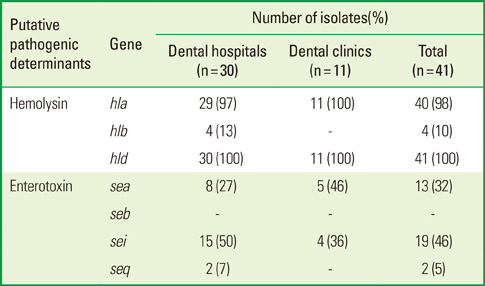1. Francis AW. Staphylococcus aureus (including toxic shock syndrome). In : Mandell GL, Bennett JE, Dolin R, editors. Principles and practices of infectious diseases. 4th ed. Philadelphia: Churchill Livingstone Elsevier;1995. p. 1754–1755.
2. Rams TE, Feik D, Slots J. Staphylococci in human periodontal diseases. Oral Microbiol Immunol. 1990; 5:29–32.

3. Dinges MM, Orwin PM, Schlievert PM. Exotoxins of Staphylococcus aureus. Clin Microbiol Rev. 2000; 13:16–34.
4. Bergdoll MS. Enterotoxins. In : Easton C, Adlam C, editors. Staphylococci and staphylococcal infections. London: Academic Press;1983. p. 559–598.
5. Wiseman GM. The hemolysins of Staphylococcus aureus. Bacteriol Rev. 1975; 39:317–361.

6. Alanis AJ. Resistance to antibiotics: are we in the post-antibiotic era? Arch Med Res. 2005; 36:697–705.

7. Cuesta AI, Jewtuchowicz V, Brusca MI, Nastri ML, Rosa AC. Prevalence of Staphylococcus spp and Candida spp in the oral cavity and periodontal pockets of periodontal disease patients. Acta Odontol Latinoam. 2010; 23:20–26.
8. Lam OL, McGrath C, Bandara HM, Li LS, Samaranayake LP. Oral health promotion interventions on oral reservoirs of Staphylococcus aureus: a systematic review. Oral Dis. 2012; 18:244–298.

9. Passariello C, Puttini M, Iebba V, Pera P, Gigola P. Influence of oral conditions on colonization by highly toxigenic Staphylococcus aureus strains. Oral Dis. 2012; 18:402–411.

10. Smith AJ, Jackson MS, Bagg J. The ecology of Staphylococcus species in the oral cavity. J Med Microbiol. 2001; 50:940–946.

11. National Research Institute of Health (KR). Diagnostic laboratory tests of infectious disease I Test methods by disease. Cheongju: National Research Institute of Health;2005.
12. Murray PR, Baron EJ, Landry ML, Jorgensen JH, Pfaller MA. Manual of clinical microbiology. Washington, DC: ASM Press;2007.
13. Kumar R, Yadav BR, Anand SK, Singh RS. Molecular surveillance of putative virulence factors and antibiotic resistance in Staphylococcus aureus isolates recovered from intra-mammary infections of river buffaloes. Microb Pathog. 2011; 51:31–39.

14. Martineau F, Picard FJ, Roy PH, Ouellette M, Bergeron MG. Species-specific and ubiquitous-DNA-based assays for rapid identification of Staphylococcus aureus. J Clin Microbiol. 1998; 36:618–641.

15. Clinical and Laboratory Standard Institute (CLSI). Performance standards for antimicrobial disk susceptibility tests; approved standard. MO2-A11 2012. p. 17–23.
16. World Health Organization. Manual for the laboratory identification and antimicrobial susceptibility testing of bacterial pathogens of public health importance in the developing world. 2003.
17. Fleming A. The antibacterial action of cultures of a Penicillium, with special reference to their use in the isolation of B. influenzae. Br J Exp Pathol. 1929; 10:226–262.
18. Nashev D, Toshkova K, Salasia SI, Hassan AA, Lämmler C, Zschöck M. Distribution of virulence genes of Staphylococcus aureus isolated from stable nasal carriers. FEMS Microbiol Lett. 2004; 233:45–52.

19. Peck KR, Baek JY, Song JH, Ko KS. Comparison of genotypes and enterotoxin genes between Staphylococcus aureus isolates from blood and nasal colonizers in a Korean hospital. J Korean Med Sci. 2009; 24:585–676.

20. Kim Y. Multiple antimicrobial resistance patterns of Staphylococcus aureus in solated from periodontitis patients in Seoul, Korea. Korean J Oral Maxillofac Pathol. 2012; 36:317–339.
21. Min JH, Park SN, Hwang HK, Min JB, Kim HS, Kook JK. Detection of methicillin or vancomycin-resistant Staphylococcus aureus from dental hospital. J Korean Acad Conserv Dent. 2007; 32:102–112.

22. Han SH, Song IS, Kim JK, Park JG, Park JH, Lee MJ, et al. Monitoring of methicillin-resistant Staphylococcus aureus in nasal swabs obtained from dental clinic healthcare providers and medical environment nurses. Int J Oral Biol. 2010; 35:7–12.
23. Kang HK. Cross infection by MRSA isolates in dental hygiene students. J Korean Acad Oral Health. 2010; 34:36–40.
24. Kim JK. Distribution and antibiotic resistance of Staphylococcus aureus in dental field. J Korean Dent Assoc. 1996; 34:110–118.
25. Lee JR, Kim YS, Chang WS, Park OS, Lee YK. Antimicrobial resistance of Staphylococcus aureus isolated from Korean oral cavity. Korean J Oral Maxillofac Pathol. 2011; 35:31–37.
26. Dental Pharmacology Professors Association in Collaboration. Drug Manuals for Clinical Dentistry. Seoul: Korea Narae Publishing;2007. p. 39–52.
27. Jung YS, Lee KW. Antimicrobial susceptibility of bacteria isolated from Korean patients. Korean J Microbiol. 1998; 24:10–12.
28. Kim YH, Moon JY, Sun YS, Kim YB, Oh YH. Detection of multidrug resistant patterns and associated-genes of methicillin resistant Staphylococcus aureus (MRSA) isolated from clinical specimens. J Life Sci. 2001; 11:24–34.
29. Kim YJ. A study of prevalence and antibiotic susceptibilities of Staphylococcus aureus in the bacterial skin infection of dermatology outpatients. Korean J Dermatol. 2001; 39:866–937.
30. Jung HJ, Cho JI, Song ES, Kim JJ, Kim GS. PCR detection of virulence genes encoding coagulase and other toxins among clinical methicillin-resistant S. aureus Isolates. Korean J Microbiol Biotechnol. 2005; 33:207–221.
31. Hwang SY, Park YK, Koo HC, Park YH. spa typing and enterotoxin gene profile of Staphylococcus aureus isolated from bovine raw milk in Korea. J Vet Sci. 2010; 11:125–156.

32. Cho YS, Lee JY, Lee MK, Shin DB, Kim DH, Park KM. Prevalence and characterization of Staphylococcus aureus pathogenic factors isolated from various foods in Korea. Korean J Food Sci Technol. 2001; 43:648–702.

33. Kim NH, Chae HS, Son HR, Kim CK, Kim SH, Lee JH, et al. Antimicrobial susceptibility and detection of enterotoxin by multiplex PCR of Staphlylococcus aureus isolated from dogs and cats in Seoul. Korean J Vet Serv. 2010; 33:263–272.
34. Baik KS, Ki GS, Choi NH, Park SC, Koh EC, Kim HR, et al. Toxins and antibiotic resistance of methicillin-resistant Staphylococcus aureus isolated from clinical specimens. J Life Sci. 2011; 21:257–321.

35. Bania J, Dabrowska A, Korzekwa K, Zarczynska A, Bystron J, Chrzanowska J, et al. The profiles of enterotoxin genes in Staphylococcus aureus from nasal carriers. Lett Appl Microbiol. 2006; 42:315–335.









 PDF
PDF ePub
ePub Citation
Citation Print
Print





 XML Download
XML Download